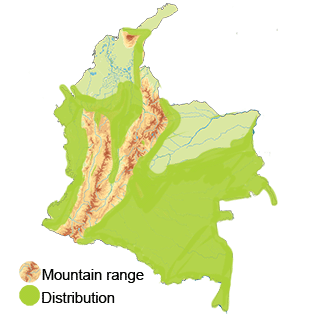Black and White Hawk-Eagle
Appearance: The Black and White Hawk-Eagle is a large bird, measuring around 56-71 cm (22-28 inches) in length with a wingspan of approximately 102-120 cm (40-47 inches). As its name suggests, it has a predominantly black and white plumage. The head, neck, and underparts are white, while the back, wings, and tail are black. It has a short, hooked beak and keen eyesight, typical of raptors.
Habitat: These birds are typically found in dense tropical forests, ranging from lowland rainforests to montane cloud forests. They prefer habitats with tall trees for perching and open spaces for hunting.
Behavior: The Black and White Hawk-Eagle is a powerful predator, preying on a variety of small to medium-sized mammals, birds, and reptiles. They are known for their agility in flight and their ability to swiftly maneuver through the dense forest canopy in pursuit of prey.
Breeding: These eagles are monogamous and typically form lifelong bonds with their mate. Breeding season can vary depending on the location, but it often coincides with the dry season. They build large stick nests high in the canopy of tall trees, where the female lays one or two eggs. Both parents take turns incubating the eggs and caring for the young.
Conservation Status: The Black and White Hawk-Eagle is classified as "Near Threatened" due to habitat loss and fragmentation caused by deforestation, as well as potential hunting pressures.
Distribution
The Black-and-white Hawk-eagle (Spizaetus melanoleucus)
Andean Region: The Andean region of Colombia, including the Andes mountain range and its foothills, provides suitable habitat for the Black-and-white Hawk-Eagle. These birds can be found in montane forests and cloud forests at various elevations within the Andean region.
Amazon Region: The Amazon region of Colombia, encompassing vast areas of tropical rainforests and river basins, also supports populations of Black-and-white Hawk-Eagles. They inhabit the dense forests and riverine habitats of the Amazon region.
Pacific Region: Along the Pacific coast of Colombia, the Black-and-white Hawk-eagle can be found in humid forests and mangrove ecosystems. The Pacific region offers diverse habitats for these raptors to thrive.
Orinoquía Region: The vast grasslands, savannas, and gallery forests of the Orinoquía region in eastern Colombia provide additional habitat for the Black-and-white Hawk-eagle. They are known to inhabit these open landscapes.
Caribbean Region: In the northern part of the country, the Caribbean region features a mix of habitats, including dry forests, mangroves, and coastal areas where Black-and-white Hawk-Eagles may also be encountered.
Taxonomy
The Black and White Hawk-eagle (Spizaetus melanoleucus)
- Kingdom: Animalia
- Phylum: Chordata
- Class: Aves (Birds)
- Order: Accipitriformes
- Family: Accipitridae
- Genus: Spizaetus
- Species: Spizaetus melanoleucus
Vocalization
The Black-and-white Hawk-Eagle (Spizaetus melanoleucus)
- Call: The vocalization of the Black-and-white Hawk-Eagle is typically a series of clear, piercing whistles or screams. Their calls are distinctive and can be heard echoing through the forest canopy as they communicate with their mates or defend their territory. The calls are often described as haunting or hauntingly beautiful.
- Territorial Display: Black-and-white Hawk-Eagles use vocalizations as part of their territorial display. They may vocalize loudly and persistently to establish their presence in an area and deter potential intruders or rival pairs from encroaching on their territory.
- Pair Bonding: Vocalizations also play a role in pair bonding between mates. Black-and-white Hawk-Eagles engage in duets, where the male and female take turns calling to each other. This vocal coordination helps strengthen the pair bond and reinforce their partnership during the breeding season.
- Communication: Beyond territorial defense and pair bonding, vocalizations are essential for communication between family members. Parents may use specific calls to communicate with their offspring, signaling food deliveries, warnings, or other important messages within the family group.
- Alarm Calls: Like many raptor species, Black-and-white Hawk-Eagles have distinct alarm calls that alert other birds and animals in the area to the presence of potential threats. These alarm calls can vary in intensity and urgency depending on the level of perceived danger.





